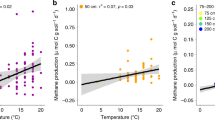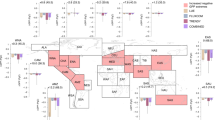Abstract
The carbon sink potential of peatlands depends on the balance of carbon uptake by plants and microbial decomposition. The rates of both these processes will increase with warming but it remains unclear which will dominate the global peatland response. Here we examine the global relationship between peatland carbon accumulation rates during the last millennium and planetary-scale climate space. A positive relationship is found between carbon accumulation and cumulative photosynthetically active radiation during the growing season for mid- to high-latitude peatlands in both hemispheres. However, this relationship reverses at lower latitudes, suggesting that carbon accumulation is lower under the warmest climate regimes. Projections under Representative Concentration Pathway (RCP)2.6 and RCP8.5 scenarios indicate that the present-day global sink will increase slightly until around ad 2100 but decline thereafter. Peatlands will remain a carbon sink in the future, but their response to warming switches from a negative to a positive climate feedback (decreased carbon sink with warming) at the end of the twenty-first century.
This is a preview of subscription content, access via your institution
Access options
Access Nature and 54 other Nature Portfolio journals
Get Nature+, our best-value online-access subscription
$29.99 / 30 days
cancel any time
Subscribe to this journal
Receive 12 print issues and online access
$209.00 per year
only $17.42 per issue
Buy this article
- Purchase on Springer Link
- Instant access to full article PDF
Prices may be subject to local taxes which are calculated during checkout




Similar content being viewed by others
Data availability
The datasets generated and analysed during the current study are available in the Supplementary Information and from the corresponding authors upon reasonable request.
References
Friedlingstein, P. et al. Climate–carbon cycle feedback analysis: results from the C4MIP model intercomparison. J. Clim. 19, 3337–3353 (2006).
Gregory, J. M., Jones, C. D., Cadule, P. & Friedlingstein, P. Quantifying carbon cycle feedbacks. J. Clim. 22, 5232–5250 (2009).
Matthews, H. D., Eby, M., Ewen, T., Friedlingstein, P. & Hawkins, B. J. What determines the magnitude of carbon cycle–climate feedbacks? Glob. Biogeochem. Cycles 21, GB2012 (2007).
Yu, Z. C., Loisel, J., Brosseau, D. P., Beilman, D. W. & Hunt, S. J. Global peatland dynamics since the Last Glacial Maximum. Geophys. Res. Lett. 37, L13402 (2010).
Spahni, R., Joos, F., Stocker, B. D., Steinacher, M. & Yu, Z. C. Transient simulations of the carbon and nitrogen dynamics in northern peatlands: from the Last Glacial Maximum to the 21st century. Clim. Past 9, 1287–1308 (2013).
Chaudhary, N., Miller, P. A. & Smith, B. Modelling Holocene peatland dynamics with an individual-based dynamic vegetation model. Biogeosciences 14, 2571–2596 (2017).
Ise, T., Dunn, A. L., Wofsy, S. C. & Moorcroft, P. R. High sensitivity of peat decomposition to climate change through water-table feedback. Nat. Geosci. 1, 763–766 (2008).
Dorrepaal, E. et al. Carbon respiration from subsurface peat accelerated by climate warming in the subarctic. Nature 460, 616–619 (2009).
Wilson, R. M. et al. Stability of peatland carbon to rising temperatures. Nat. Commun. 7, 13723 (2011).
Blodau, C., Siems, M. & Beer, J. Experimental burial inhibits methanogenesis and anaerobic decomposition in water-saturated peats. Environ. Sci. Technol. 45, 9984–9989 (2011).
Loisel, J. et al. A database and synthesis of northern peatland soil properties and Holocene carbon and nitrogen accumulation. Holocene 24, 1028–1042 (2014).
Charman, D. J. et al. Climate-related changes in peatland carbon accumulation during the last millennium. Biogeosciences 10, 929–944 (2013).
Yu, Z. Holocene carbon flux histories of the world’s peatlands: global carbon cycle implications. Holocene 21, 761–774 (2011).
Dargie, G. C. et al. Age, extent and carbon storage of the central Congo Basin peatland complex. Nature 542, 86–90 (2017).
Michaletz, S. T., Cheng, D., Kerkhoff, A. J. & Enquist, B. J. Convergence of terrestrial plant production across global climate gradients. Nature 512, 39–43 (2014).
Wang, H. et al. Towards a universal model for carbon dioxide uptake by plants. Nat. Plants 3, 734–741 (2017).
Jones, C. et al. Twenty-first-century compatible CO2 emissions and airborne fraction simulated by CMIP5 Earth System models under four Representative Concentration Pathways. J. Clim. 26, 4398–4413 (2013).
Gorham, E. Northern peatlands: role in the carbon cycle and probable responses to climatic warming. Ecol. Appl. 1, 182–195 (1991).
Korhola, A., Alm, J., Tolonen, K., Turunen, J. & Jungner, H. Three-dimensional reconstruction of carbon accumulation and CH4 emission during nine millenia in a raised mire. J. Quat. Sci. 11, 161–165 (1996).
Väliranta, M. et al. Holocene fen–bog transitions, current status in Finland and future perspectives. Holocene 27, 752–764 (2017).
Cooper, M. D. A. et al. Limited contribution of permafrost carbon to methane release from thawing peatlands. Nat. Clim. Change 7, 507–511 (2017).
Jones, M. C. et al. Rapid carbon loss and slow recovery following permafrost thaw in boreal peatlands. Glob. Change Biol. 23, 1109–1127 (2017).
Ott, C. A. & Chimner, R. A. Long-term peat accumulation in temperate forested peatlands (Thuja occidentalis swamps) in the Great Lakes region of North America. Mires Peat 18, 1–9 (2016).
Wang, H., Richardson, C. J., & Ho, M. Dual controls on carbon loss during drought in peatlands. Nat. Clim. Change 5, 584–587 (2015).
Page, S. E. et al. The amount of carbon released from peat and forest fires in Indonesia during 1997. Nature 420, 61–65 (2002).
Moore, S. et al. Deep instability of deforested tropical peatlands revealed by fluvial organic carbon fluxes. Nature 493, 660–663 (2013).
Cressie, N. A. C. Statistics for Spatial Data (John Wiley & Sons Inc, New York, 1993).
Bol, R. A., Harkness, D. D., Huang, Y. & Howard, D. M. The influence of soil processes on carbon isotope distribution and turnover in the British uplands. Eur. J. Soil Sci. 50, 41–51 (1999).
New, M., Hulme, M. & Jones, P. D. Representing twentieth century space–time climate variability. Part 1: development of a 1961–90 mean monthly terrestrial climatology. J. Clim. 12, 829–856 (1999).
Gallego-Sala, A. V., & Prentice, I. C. Blanket peat biome endangered by climate change. Nat. Clim. Change 3, 152–155 (2013).
Diggle, P. & Riberio, P. J. Jr. Model-based Geostatistics (Springer, New York, 2007).
Goovaerts, P. Geostatistics for Natural Resources Evaluation (Oxford Univ. Press, Oxford, 1997).
Pebesma, E. J. Multivariable geostatistics in S: the gstat package. Comput. Geosci. 30, 683–691 (2004).
Hijmans, R. J. et al. Raster: geographic analysis and modeling with raster data. R package v.2.5-8. (CRAN, 2016); https://cran.r-project.org/web/packages/raster/index.html
IPCC Climate Change 2014: Synthesis Report (eds Core Writing Team, Pachauri, R. K. & Meyer L. A.) (IPCC, 2014).
Jones, C. D. et al. The HadGEM2-ES implementation of CMIP5 centennial simulations. Geosci. Model Dev. 4, 543–570 (2011).
Collins, W. J. et al. Development and evaluation of an Earth-System model – HadGEM2. Geosci. Model Dev. 4, 1051–1075 (2011).
Acknowledgements
The work presented in this paper was funded by the Natural Environment Research Council (NERC standard grant number NE/I012915/1) to D.J.C., A.G.S., I.C.P., S.P. and P.F., supported by NERC Radiocarbon Allocation 1681.1012. The work and ideas in this paper have also been supported by PAGES funding, as part of C-PEAT. C.D.J. was supported by the Joint UK DECC/Defra Met Office Hadley Centre Climate Programme (GA01101). This research is also a contribution to the AXA Chair Programme in Biosphere and Climate Impacts and the Imperial College initiative on Grand Challenges in Ecosystems and the Environment. This research was also supported by a grant from the National Science Centre, Poland 2015/17/B/ST10/01656. We thank D. Vitt, J. Alm, I. E. Bauer, N. Rausch, V. Beaulieu-Audy, L. Tremblay, S. Pratte, A. Lamarre, D. Anderson and A. Ireland for contributing data to this compilation, S. Frolking for suggestions on different moisture indexes, and A. Whittle and F. Dearden for their work in the Exeter laboratories.
Author information
Authors and Affiliations
Contributions
A.G.S. carried out analysis and interpretation of the data and wrote the first draft of the paper. D.J.C. supervised the project and contributed to experimental design, interpretation of results and the final draft. S.Br. carried out the statistical and spatial analysis of the data and contributed to the design of the final figures. S.M. was responsible for new radiocarbon analyses. Z.Y. provided the peatland map used in the modelling and contributed data and materials. C.J. provided climate and gross primary productivity data. L.O. carried out the age-depth models for all cores. All authors contributed either data or materials to be analysed in the Geography laboratories at the University of Exeter. All authors contributed to the preparation of the final paper.
Corresponding authors
Ethics declarations
Competing interests
The authors declare no competing interests.
Additional information
Publisher’s note: Springer Nature remains neutral with regard to jurisdictional claims in published maps and institutional affiliations.
Supplementary information
Supplementary Information
Supplementary Tables 1–3, Supplementary Figures 1–5 and Supplementary References.
Rights and permissions
About this article
Cite this article
Gallego-Sala, A.V., Charman, D.J., Brewer, S. et al. Latitudinal limits to the predicted increase of the peatland carbon sink with warming. Nature Clim Change 8, 907–913 (2018). https://doi.org/10.1038/s41558-018-0271-1
Received:
Accepted:
Published:
Issue Date:
DOI: https://doi.org/10.1038/s41558-018-0271-1
This article is cited by
-
Interplay of Climate, Fires, Floods, and Anthropogenic Impacts on the Peat Formation and Carbon Dynamic of Coastal and Inland Tropical Peatlands in West Kalimantan, Indonesia
Ecosystems (2024)
-
Elevation and temperature are strong predictors of long-term carbon accumulation across tropical Andean mountain peatlands
Mitigation and Adaptation Strategies for Global Change (2024)
-
Wildfire and degradation accelerate northern peatland carbon release
Nature Climate Change (2023)
-
Topographic and climatic controls of peatland distribution on the Tibetan Plateau
Scientific Reports (2023)
-
Climate warming and elevated CO2 alter peatland soil carbon sources and stability
Nature Communications (2023)



